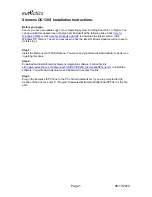
IP Unicast Routing
ExtremeWare XOS 11.1 Concepts Guide
368
NOTE
If you define multiple default routes, the route that has the lowest metric is used. If multiple default routes have the
same lowest metric, the system picks one of the routes.
You can also configure
blackhole
routes—traffic to these destinations is silently dropped.
IP Route Sharing
IP route sharing allows multiple equal-cost routes to be used concurrently. IP route sharing can be used
with static routes or with OSPF routes. In OSPF, this capability is referred to as equal cost multipath
(ECMP) routing. To use IP route sharing, use the following command:
enable iproute sharing
Next, configure static routes and/or OSPF as you would normally. ExtremeWare XOS supports
unlimited route sharing across static routes and up to 12 ECMP routes for OSPF. Route sharing is useful
only in instances where you are constrained for bandwidth. This is typically not the case using Extreme
switches. Using route sharing makes router troubleshooting more difficult because of the complexity in
predicting the path over which the traffic will travel.
Proxy ARP
Proxy Address Resolution Protocol (ARP) was first invented so that ARP-capable devices could respond
to ARP request packets on behalf of ARP-incapable devices. Proxy ARP can also be used to achieve
router redundancy and to simplify IP client configuration. The switch supports proxy ARP for this type
of network configuration. The section describes some example of using proxy ARP with the switch.
ARP-Incapable Devices
To configure the switch to respond to ARP requests on behalf of devices that are incapable of doing so,
you must configure the IP address and MAC address of the ARP-incapable device using the use the
following command:
configure iparp add proxy [<ipNetmask> | <ip_addr> {<mask>}] {vr <vr_name>} {<mac>}
{always}
After it is configured, the system responds to ARP requests on behalf of the device as long as the
following conditions are satisfied:
●
The valid IP ARP request is received on a router interface.
●
The target IP address matches the IP address configured in the proxy ARP table.
●
The proxy ARP table entry indicates that the system should answer this ARP request, based on the
ingress VLAN and whether the
always
parameter is set. When the
always
option is set, the switch
will ARP for the host even if the ARP requester is on the same subnet as the requested host. If the
always
option is not set, the switch will only answer if the ARP request comes in from a VLAN that
is not on the same subnet as the requested host.
When all the proxy ARP conditions are met, the switch formulates an ARP response using the
configured MAC address in the packet.
Содержание ExtremeWare XOS 11.1
Страница 16: ...Contents ExtremeWare XOS 11 1 Concepts Guide 16...
Страница 20: ...Preface ExtremeWare XOS 11 1 Concepts Guide 20...
Страница 21: ...1 Using ExtremeWare XOS...
Страница 22: ......
Страница 78: ...Managing the ExtremeWare XOS Software ExtremeWare XOS 11 1 Concepts Guide 78...
Страница 168: ...Virtual LANs ExtremeWare XOS 11 1 Concepts Guide 168...
Страница 200: ...Policies and ACLs ExtremeWare XOS 11 1 Concepts Guide 200...
Страница 252: ...Security ExtremeWare XOS 11 1 Concepts Guide 252...
Страница 265: ...2 Using Switching and Routing Protocols...
Страница 266: ......
Страница 294: ...Ethernet Automatic Protection Switching ExtremeWare XOS 11 1 Concepts Guide 294...
Страница 354: ...Extreme Standby Router Protocol ExtremeWare XOS 11 1 Concepts Guide 354...
Страница 416: ...IP Multicast Routing ExtremeWare XOS 11 1 Concepts Guide 416...
Страница 417: ...3 Appendixes...
Страница 418: ......
Страница 432: ...Software Upgrade and Boot Options ExtremeWare XOS 11 1 Concepts Guide 432...
















































